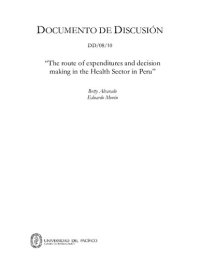
Ebook: The route of expenditures and decision making in the Health Sector in Peru
Author: Betty Alvarado Eduardo Morón
- Genre: Other Social Sciences // Sociology
- Tags: Peru, Health sector Peru decision making
- Series: Documento de Discusión, DD/08/10
- Year: 2008
- Publisher: Universidad del Pacífico (UP) - CIUP
- City: Lima
- Language: English
- pdf
The Public Health Sector in Peru primarily serves the poor. Its performance, as measured by health
status outcomes, has been positive in some areas such as immunization coverage, reduction of infant
mortality, and increases in institutional baby deliveries. However, there are still problems that need to be
addressed such as maternal mortality and cross-sectoral issues such as full equity and risk protection. But
from a budgetary perspective, there is no clear correlation between the amount of money allocated and
health outcomes. This is explained by the fact that there is no established causality between inputs and
results and that the processes in expending public monies are cumbersome, not transparent, inefficient,
and full of loopholes that have created perverse incentives.
The main objective of the study was to gain a clear understanding of the logic and sequence of budget
flows and to discover bottlenecks throughout the process that can impede the adequate use of limited
resources. In addition, the study reviews the relationship between flows and expenditures, on the one
hand, and the flows and decision-making process on the other hand. In as much as possible, the study
follows Public Expenditure Tracking Survey (PETS) Methodology and applies it to one health cluster in
Metropolitan Lima.
The study was exploratory but results were promising and the implementation of a survey gave us
enough information to firmly state that “it is not only a question of how much money the sector is
assigned, but also of how and when the resources reach the frontline providers”. The analysis of frontline
providers and intermediate-level agencies in this study identified institutional bottlenecks and possible
perverse incentives that reduce positive budget incidence. Constraints and perverse incentives are present
in the salary structure, the use of fee collection and petty cash management, procurement rules, and
elsewhere. The current context in Peru, where a Results-Based Budget is being piloted, provides an
opportunity to incorporate adjustments in the management processes.
Key words: Health sector, Peru, decision making
status outcomes, has been positive in some areas such as immunization coverage, reduction of infant
mortality, and increases in institutional baby deliveries. However, there are still problems that need to be
addressed such as maternal mortality and cross-sectoral issues such as full equity and risk protection. But
from a budgetary perspective, there is no clear correlation between the amount of money allocated and
health outcomes. This is explained by the fact that there is no established causality between inputs and
results and that the processes in expending public monies are cumbersome, not transparent, inefficient,
and full of loopholes that have created perverse incentives.
The main objective of the study was to gain a clear understanding of the logic and sequence of budget
flows and to discover bottlenecks throughout the process that can impede the adequate use of limited
resources. In addition, the study reviews the relationship between flows and expenditures, on the one
hand, and the flows and decision-making process on the other hand. In as much as possible, the study
follows Public Expenditure Tracking Survey (PETS) Methodology and applies it to one health cluster in
Metropolitan Lima.
The study was exploratory but results were promising and the implementation of a survey gave us
enough information to firmly state that “it is not only a question of how much money the sector is
assigned, but also of how and when the resources reach the frontline providers”. The analysis of frontline
providers and intermediate-level agencies in this study identified institutional bottlenecks and possible
perverse incentives that reduce positive budget incidence. Constraints and perverse incentives are present
in the salary structure, the use of fee collection and petty cash management, procurement rules, and
elsewhere. The current context in Peru, where a Results-Based Budget is being piloted, provides an
opportunity to incorporate adjustments in the management processes.
Key words: Health sector, Peru, decision making
Download the book The route of expenditures and decision making in the Health Sector in Peru for free or read online
Continue reading on any device:

Last viewed books
Related books
{related-news}
Comments (0)